Integrating Temporal Dimensions in Circularity of the Built Environment Analysis of Two Flemish Industrial Parks
Abstract
1. Introduction
1.1. Circularity for a Sustainable Industrial Transformation
1.2. Integrating Socio-Economic and Ecological Time Dimensions in Industrial Built Environment Design
1.3. Re-Introduction of ‘Time Is Life’
2. Materials and Methods
2.1. Industry Parks Kortrijk-Noord and Haasrode
2.2. Qualitative Design Research
2.3. Visualizations as a Research Method
2.4. Diachronic Mapping
3. Results and Discussion
3.1. Case 1: Kortrijk-Noord
3.1.1. Cyclic Proto-Industries (1777–1840)
3.1.2. Industrialization—Since 1970
3.1.3. Project Frameworks for the Circular Built Environment of Kortrijk-Noord
- Harness proto-circularity for a circular future in Kortrijk-Noord.
- Foster circular ecosystems between industry and nature.
- Integrate circular water management as a landscape structure.
3.2. Case 2: Haasrode
3.2.1. ‘Time Is Life’ in Medieval Haasrode
3.2.2. Industrialization—Since 1970
3.2.3. Project Frameworks for the Circular Built Environment of Haasrode
- Harmonizing business agility with spatial inertia.
- Circular ecosystem between industry and nature for groundwater protection.
- Potential of the open lawns for diversification and multi-species richness.
3.3. Reflections on the Introduction of Temporal Dimensions Within Case Study Research
- The value of context-specific approaches in capturing temporal dynamics.
- The importance of long-term cycles for circularity of the built environment.
- Temporal awareness of business cycles and local collaborations.
- Qualitative methods in circularity research.
4. Conclusions
Author Contributions
Funding
Institutional Review Board Statement
Informed Consent Statement
Data Availability Statement
Acknowledgments
Conflicts of Interest
Appendix A
| Haasrode | Kortrijk-Noord | |||
|---|---|---|---|---|
| Impact on Soil | Type of Business | Impact on Soil | Type of Business | |
| 1777 | Incorporating practices of resource reuse, such as reusing casks for beer maturation, the Norbertine abbey’s agricultural activities were centered on self-sufficiency, combining farming, forestry, and brewing [72]. Circular land management techniques promoted soil health and biodiversity, including crop rotation and alternating fields. By cultivating diverse plant species and employing organic methods, the abbey supported natural nutrient cycling and maintained a balanced ecosystem [74]. | Farmers with small-scale proto-industries process flax into linen at home. They were farmers in the first place and used small plots for flax production for extra income. The cyclical process of flax farming (growth, bloom, rest, renewal) and crop rotation maintained soil fertility and supported a biodiverse ecosystem. They adopted a circular use of by-products (e.g., linseed oil, fuel, animal feed) [59]. | ||
| 1840 | After the dissolution of the Abbey, the fertile land was used for mixed farming and livestock management. Over time, agricultural intensification introduced synthetic fertilizers and pesticides, leading to soil degradation [62]. Using synthetic chemicals and heavier machinery caused soil compaction and reduced biodiversity, while the shift to monoculture practices further deteriorated soil health [75]. | A shift from small-scale family production to centralized industrial manufacturing facilities in Northern France led to an industrial re-orientation in Kortrijk-Noord towards a specialization in flax processing, a well-known industry requiring little investment [59]. At the same time, the region had to deal with an agricultural crisis. Introducing chemical fertilizers increased agricultural production but reduced soil biodiversity and fertility [62]. Agricultural practices became more extractive. | ||
| 1970 | Soil sealing (lawns, concrete surfaces, buildings) decreased infiltration and biodiversity. Monofunctional buildings and esthetic green spaces replaced agricultural lands. | The expropriation and transformation of agricultural land into Haasrode Industry Park are beginning. It is modeled after American science parks and focuses on global, knowledge-intensive R&D companies [36]. | Soil sealing (asphalt, concrete, buildings) caused a decline in soil health. Sealed surfaces prevent natural nutrient cycling, reducing biological activity and ecosystem vitality. | Industrial manufacturing park. Many businesses grew out of former flax-based family enterprises. The focus shifted gradually to large-scale production, logistics, and manufacturing within a family enterprise structure [26]. |
| 1990 | Topsoil removal and sealing during construction disrupt rainwater infiltration. Installment of ‘Protection Zones for Water Extraction Areas’ [41]. In contradiction with landfill operations and fire suppression at the industrial park contributing to unnoticed soil contamination [77,78]. | Continued industrial development. Most office buildings are constructed at this time. Financial incentives created favorable (unsustainable) investment conditions [24]. | An intensification of the industrial built environment and sealed soil creates negligence and a less regulated environment regarding pollution and water extraction. | Incremental expansion of local family businesses; reorientation of businesses linked to the declining flax industry; reuse of buildings. Kortrijk-Noord forms an industrial ecosystem (manufacturing, packaging, maintenance,…). |
| 2024 | Soil and groundwater contamination remain significant issues; however, interest in the industrial open landscape’s potential stays low. Fear for creating biological value [76]. Limited rainwater infiltration due to legal restrictions. Contaminated sites pose future risks to drinking water quality. | Research and innovation campus. Local authorities have increased focus on circularity and climate neutrality. Multinational companies: “What’s in it for me?” [76]. | Groundwater depletion and soil contamination (manganese and nitrate pollution) are tucked beneath the concrete surface. Vulnerability to climate extremes (heavy rainfall and droughts). Shallow, unsaturated soil zones are susceptible to pollution [42]. Improved awareness, governments in search for adapted policies [67]. | Regional industry park. Many businesses still originate from 1970. Repair and adaptive reuse, frugality in family business, proto-circular practices [65]. Confronted with opaque (European) rules and regulations. |
References
- Hahn, T. Green Economy, economic growth and sustainable development. In Access to Resources, an Urban Agenda; Palmer, H., Ed.; Spurbuchverlag: Baunach, Germany, 2014. [Google Scholar]
- Westley, F.; Olsson, P.; Folke, C.; Homer-Dixon, T.; Vredenburg, H.; Loorbach, D.; Thompson, J.; Nilsson, M.; Lambin, E.; Sendzimir, J.; et al. Tipping toward sustainability: Emerging pathways of transformation. AMBIO J. Environ. Soc. 2011, 40, 762–780. [Google Scholar] [CrossRef] [PubMed]
- Pomponi, F.; Moncaster, A. Circular economy for the built environment: A research framework. J. Clean. Prod. 2017, 143, 710–718. [Google Scholar] [CrossRef]
- Gregson, N.; Crang, M.; Fuller, S.; Holmes, H. Interrogating the circular economy: The moral economy of resource recovery in the EU. Econ. Soc. 2015, 44, 218–243. [Google Scholar] [CrossRef]
- Murray, A.; Skene, K.; Haynes, K. The Circular Economy: An interdisciplinary exploration of the concept and application in a Global context. J. Bus. Ethics 2017, 140, 369–380. [Google Scholar] [CrossRef]
- Calisto Friant, M.; Vermeulen, W.J.V.; Salomone, R. Transition to a Sustainable Circular Society: More than Just Resource Efficiency. Circ. Econ. Sustain. 2023, 4, 23–42. [Google Scholar] [CrossRef]
- Bortolotti, A.; Verga, G.C.; Khan, A.Z. Which circularity for urban design and planning? A compass to navigate circular economy research knowledge and methods. Plan. Pract. Res. 2023, 1–20. [Google Scholar] [CrossRef]
- Calisto Friant, M.; Vermeulen, W.J.V.; Salomone, R. A typology of circular economy discourses: Navigating the diverse visions of a contested paradigm. Resour. Conserv. Recycl. 2020, 161, 104917. [Google Scholar] [CrossRef]
- Furlan, C.; Wandl, A.; Cavalieri, C.; Muñoz Unceta, P. Territorialising Circularity. In Regenerative Territories, Dimensions of Circularity for Healthy Metabolisms; Russo, M., Amenta, L., van Timmeren, A., Eds.; Springer: Berlin/Heidelberg, Germany, 2022. [Google Scholar]
- Bundesamt, U. The impossibilities of the Circular Economy: Separating Aspirations from Reality. In Factor X: Studies in Sustainable Natural Resource Management; Lehmann, H., Hinske, C., de Margerie, V., Nikolova, A.S., Eds.; Routledge: Abingdon-on-Thames, UK, 2024. [Google Scholar]
- Marin, J. Circular Economy Transition in Flanders, an Urban Landscape Design Contribution. Ph.D. Thesis, Department of Architecture, KU Leuven, Leuven, Belgium, 2019. [Google Scholar]
- Raworth, K. Doughnut Economics: Seven Ways to Think Like a 21st-Century Economist; Random House: London, UK, 2017; p. 288. [Google Scholar]
- Berkes, F.; Colding, J.; Folke, C. (Eds.) Navigating Social-Ecological Systems: Building Resilience for Complexity and Change; Cambridge University Press: Cambridge, UK, 2003. [Google Scholar]
- Marin, J.; de Meulder, B. Interpreting Circularity. Circular City Representations Concealing Transition Drivers. Sustainability 2018, 10, 1310. [Google Scholar] [CrossRef]
- Rappaport, N. Vertical Urban Factory; Actar Publishers: New York, NY, USA, 2019. [Google Scholar]
- Allacker, K.; de Meulder, B.; Dewil, R.; Marin, J.; Ottoy, S. Research Proposal Regenerating Flemish Industry Parks; KU Leuven: Leuven, Belgium, 2019. [Google Scholar]
- InterLeuven. CIRCULER, Samen op Weg Naar Een Circulair Bedrijventerrein; InterLeuven: Leuven, Belgium, 2021. [Google Scholar]
- Verbiest, E.; De Meulder, B.; Marin, J.; Vande Moere, A. Identifying site-specific circularity potential in the built environment through socio-spatial visualizations. Plan. Pract. Res. 2024, 1–18. [Google Scholar] [CrossRef]
- TOTEM—Environmental Impact Calculation Tool for Buildings. Available online: https://www.totem-building.be/ (accessed on 17 November 2024).
- Waring, R.H.; Running, S.W. CHAPTER 1—Forest Ecosystem Analysis at Multiple Time and Space Scales. In Forest Ecosystems, 3rd ed.; Waring, R.H., Running, S.W., Eds.; Academic Press: San Diego, CA, USA, 2007; pp. 1–16. [Google Scholar]
- Vrebos, D.; Staes, J.; Bennetsen, E.; Broexkx, S.; De Nocker, L.; Gabriels, K.; Goethals, P.; Hermy, M.; Liekens, I.; Marsboom, C.; et al. ECOPLAN-SE: Ruimtelijke Analyse van Ecosysteemdiensten in VLAANDEREN, Een Q-GIS Plugin, 1st ed.; 017-R202 Universiteit Antwerpen: Antwerpen, Belgium, 2017. [Google Scholar]
- Palea, V.; Santhià, C.; Miazza, A. Are circular economy strategies economically successful? Evidence from a longitudinal panel. J. Environ. Manag. 2023, 337, 117726. [Google Scholar] [CrossRef]
- Ghisellini, P.; Cialani, C.; Ulgiati, S. A review on circular economy: The expected transition to a balanced interplay of environmental and economic systems. J. Clean. Prod. 2016, 114, 11–32. [Google Scholar] [CrossRef]
- Rau, T.; van Bergen, T.; Driever, D.; Mouser, I.; Havenga, D.; Manschot, D.; Menger, O.; Verbaan, J. Van Vastgoed Naar Losgoed, Nieuwe Financiële Baten Van Circulariteit Voor Vastgoedeigenaren; Deloitte: The Netherlands, 2019; Available online: https://www.bouwinvest.nl/media/4322/van-vastgoed-naar-losgoed.pdf (accessed on 10 September 2024).
- Lafuente, E.; García-Cestona, M.Á. CEO turnover in public and private organizations: Analysis of the relevance of different performance horizons. J. Econ. Financ. Adm. Sci. 2021, 26, 333–357. [Google Scholar] [CrossRef]
- Lambrecht, J. Het Familiebedrijf, in Goede en Kwade Dagen; Owl Press: Gent, Belgium, 2022. [Google Scholar]
- De Meulder, B.; Marin, J.; Shannon, K. Evolving Relations of Landscape, Infrastructure and Urbanization Toward Circularity: Flanders and Vietnam. In Regenerative Territories: Dimensions of Circularity for Healthy Metabolisms; Amenta, L., Russo, M., van Timmeren, A., Eds.; Springer Nature Switzerland AG: Cham, Switzerland, 2022; Volume 128, pp. 107–121. [Google Scholar]
- Haraway, D. Staying with the Trouble, Making Kin in the Chthulucene; Duke University Press: Durham, UK, 2016. [Google Scholar]
- de La Bellacasa, M.P. Matters of Care: Speculative Ethics in More Than Human Worlds; Wolfe, C., Ed.; Posthumanities; University of Minnesota Press: Minneapolis, MN, USA, 2017. [Google Scholar]
- Escobar, A. Radical Interdependence, Autonomy, and the Making of Worlds. In Designs for the Pluriverse; Duke University Press: Durham, UK; London, UK, 2018; p. 290. [Google Scholar]
- Hutton, J. Reciprocal Landscapes: Stories of Material Movements; Routledge: London, UK, 2019; p. 232. [Google Scholar]
- Marin, J.; de Meulder, B. Time is life. In Ruimte; Vlaamse Vereniging voor Ruimte en Planning (VRP): Antwerp, Belgium, 2021; pp. 22–25. [Google Scholar]
- Escobar, A. Foreword: Repair on the move. In Repair: Sustainable Design Futures; Markus Berger, K.I., Ed.; Routledge: London, UK, 2022; p. 288. [Google Scholar]
- Burns, G.W. Gross National Happiness: A Gift from Bhutan to the World. In Positive Psychology as Social Change; Biswas-Diener, R., Ed.; Springer: Dordrecht, The Netherlands, 2011; pp. 73–88. [Google Scholar]
- Bardgett, R.D. Earth Matters. How Soil Underlies Civilization; Oxford University Press: Oxford, UK, 2016. [Google Scholar]
- Stad Leuven. Studie-en Ontwerpopdracht “Masterplan Haasrode”. 2021.
- SWECO. Bedrijventerreinen van de Toekomst: Transitieplan Kortrijk-Noord; POM West-Vlaanderen: Sint-Andries, Belgium, 2020. [Google Scholar]
- Bredies, K. Introduction. In Design as Research; Joost, G., Bredies, K., Christensen, M., Conradi, F., Unteidig, A., Eds.; Birkhäuser: Berlin, Germany; Boston, MA, USA, 2020; pp. 12–16. [Google Scholar]
- Rowe, P.G. Design Thinking; MIT Press: Cambridge, MA, USA, 1987. [Google Scholar]
- Hennink, M.; Hutter, I.; Bailey, A. Qualitative Research Methods, 2nd ed.; SAGE Publications Ltd.: Thousand Oaks, CA, USA, 2020. [Google Scholar]
- Geopunt. Available online: https://www.geopunt.be/ (accessed on 18 June 2024).
- Data Ondergrond Vlaanderen. Available online: https://www.dov.vlaanderen.be/portaal/?module=verkenner (accessed on 18 June 2024).
- Agentschap Natuur en Bos; Departement Omgeving; Natuurpunt; Corridor. Green Deal: Bedrijven en Biodiversiteit; Vlaamse Overheid: Brussels, Belgium, 2018; p. 54. [Google Scholar]
- Departement Omgeving. Green Deal: Natuurinclusieve Parkeerterreinen. 2024. Available online: https://omgeving.vlaanderen.be/nl/green-deal-natuurinclusieve-parkeerterreinen-016 (accessed on 18 June 2024).
- De Vlaamse Minister van Justitie en Handhaving, Omgeving, Energie en Toerisme. Hemelwaterverordening: Verslag aan de VR; Departement Omgeving: Brussels, Belgium, 2023; p. 35. [Google Scholar]
- Houtum, H.V. Free the Map: From Atlas to Hermes: A New Cartography of Borders and Migration; nai010 Publishers: Rotterdam, The Netherlands, 2024; p. 200. [Google Scholar]
- Davila, P. Diagrams of Power: Visualizing, Mapping, and Performing Resistance; Onomatopee: Eindhoven, The Netherlands, 2019. [Google Scholar]
- Schranz, C. Shifts in Mapping Maps as a Tool of Knowledge; Kulturgeographie, S.-U., Ed.; Transcript Verlag: Bielefeld, Germany, 2021; Volume 54, p. 293. [Google Scholar]
- Lomme, F.; Holmes, B. An Atlas of Agendas: Mapping the Power, Mapping the Commons; Bureau d’Études, Ed.; Onomatopee: Eindhoven, The Netherlands, 2013. [Google Scholar]
- Metabolism of Cities, Data Visualization Examples. Available online: https://archive.metabolismofcities.org/datavisualization/examples (accessed on 22 August 2024).
- Keena, N.; Friedman, A.; Parsaee, M.; Klein, A. Data Visualization for a Circular Economy: Designing a Web Application for Sustainable Housing. Technol. Archit. Des. 2023, 7, 262–281. [Google Scholar] [CrossRef]
- Circular Built Environment Hub. Available online: https://www.tudelft.nl/bk/onderzoek/onderzoeksthemas/circular-built-environment (accessed on 22 August 2024).
- Lobosco, G. Visualising Time and Uncertainty. OASE J. Archit. 2020, 107, 114–116. [Google Scholar]
- Cattoor, B. Designerly mapping practices at the crossroads of cartography and urbanism: A processual account of three re-cartographies of southwest Flanders. Environ. Plan. A Econ. Space 2015, 47, 1283–1297. [Google Scholar] [CrossRef]
- Palaiologou, G.; Griffiths, S. The Uses of Space Syntax Historical Research for Policy Development in Heritage Urbanism; Springer International Publishing: Cham, Switzerland, 2019; pp. 19–34. [Google Scholar]
- Dixon, S. Landscape Processes as Site Context. In Site Matters: Strategies for Uncertainty Through Planning and Design; Burns, C.J., Kahn, A., Eds.; Routledge: London, UK, 2021; pp. 101–109. [Google Scholar]
- Decroos, B. A Construction of Time. OASE J. Archit. 2020, 105, 120–123. [Google Scholar]
- Aït-Touati, F.; Arènes, A.; Grégoire, A. Terra Forma: A Book of Speculative Maps, 2nd ed.; The MIT Press: Cambridge, MA, USA, 2022. [Google Scholar]
- Buyse, L.; Velghe, D. De Vlasnijverheid in Zuid-West-Vlaanderen, synthese van een boeiend verhaal. Tijdschr. voor Ind. Cult. 2011, 28, 115. [Google Scholar] [CrossRef]
- Jones, G.E.; Garforth, C. The History, Development, and Future of Agricultural Extension; Food and Agriculture Organization (FAO): Rome, Italy, 1997. [Google Scholar]
- Gardi, C.; Jeffery, S. Soil Biodiversity; Office for Official Publications of the European Communities: Luxembourg, 2009; Volume 27. [Google Scholar]
- Fisher, S. The Evolution of Chemical Pesticides. Lab Reporter. 2016. Available online: https://www.fishersci.com/us/en/scientific-products/publications/lab-reporter/2016/issue-4/the-evolution-chemical-pesticides.html (accessed on 10 September 2024).
- De Meulder, B.; Hoornaert, S.; Van Herck, K. (Eds.) Metamorfosen, een ruimtelijke biografie van de regio Kortrijk; Intercommunale Leiedal, Dexia nv: Brussel, Belgium, 2010. [Google Scholar]
- Prideaux, F.; Allacker, K.; Crawford, R.H.; Stephan, A. Integrating life cycle assessment into the building design process-a review. Environ. Res. Infrastruct. Sustain. 2024, 4, 1–23. [Google Scholar] [CrossRef]
- Verbiest, E.; Marin, J.; De Meulder, B.; Vande Moere, A. Untangling Stakeholder Dynamics in Circularity of the Built Environment. Spool 2023, 10, 73–86. [Google Scholar] [CrossRef]
- Ford, H. Today and Tomorrow; Routledge: London, UK, 2019. [Google Scholar]
- VLAKWA. Leidraad Voor Het Realiseren van Waterneutraliteit op een Bestaand Bedrijventerrein; POM West-Vlaanderen: Sint-Andries, Belgium, 2024; p. 25. [Google Scholar]
- Ysebaert, T.; Sonck, T. Hoe Vlaanderen aan zijn mestprobleem kwam. De Standaard, 15 January 2023. [Google Scholar]
- Wyck, B.V. On Creating a Usable Past. The Dial, 11 April 1918; pp. 337–341. [Google Scholar]
- Malterre-Barthes, C.; Dzierzawska, Z. Architecture without extraction. The Architectural Review, 1 November 2021. [Google Scholar]
- Hidalgo, J.; Gomez-Sagasti, M.T.; Anza, M.; Artetxe, U.; Epelde, L.; Becerril, J.M.; Garbisu, C. Chapter Four—Plant-based remediation of industrially contaminated soils: Principles and case study. Adv. Bot. Res. 2024, 109, 105–158. [Google Scholar]
- Abdijvanpark, L. Park Abbey: A Food-Filled Past, Present and Future. 2021. Available online: https://www.abdijvanpark.be/en/park-abbey-food-filled-past-present-and-future (accessed on 18 June 2024).
- Van Hemelrijck, D. A genealogy of industry, an analysis of Historical industrialization waves adapted to Kortrijk Noord and Leuven Haasrode. In Proceedings of the 8th International World Urbanism Seminar, Leuven, Belgium, 15 June 2021. [Google Scholar]
- Weston, P. The age of extinction: More than half of Earth’s species live in the soil, study finds. The Guardian, 7 August 2023. [Google Scholar]
- Balogh, A. The rise and fall of monoculture farming. Horizon Magazine, 13 December 2021. [Google Scholar]
- Verbiest, E.; De Meulder, B.; Marin, J.; Vande Moere, A. A walkshop method to contextualize circularity potential. In Proceedings of the 9th International World Urbanisms Seminar, Leuven, Belgium, 30 June 2022; Department of Architecture, KU Leuven: Leuven, Belgium, 2022; pp. 7–12. [Google Scholar]
- Neyens, C. Reactive transport modelling of point source contaminations in groundwater: Model input and process abstraction. In Faculty of Engineering, Department of Hydrology and Hydraulic Engineering; Vrije Universiteit Brussel: Brussel, Belgium, 2022; p. 205. [Google Scholar]
- Vlaamse MilieuMaatschappij. PFAS in de Bronnen; Vlaamse MilieuMaatschappij: Brussels, Belgium, 2022; Available online: https://publicaties.vlaanderen.be/view-file/50068 (accessed on 10 September 2024).
- Bjornerud, M. Timefulness: How Thinking Like a Geologist Can Help Save the World; Princeton University Press: Princeton, NJ, USA, 2020; p. 224. [Google Scholar]
- Zhu, Z.; Qiu, S.; Ye, S. Remote sensing of land change: A multifaceted perspective. Remote Sens. Environ. 2022, 282, 113266. [Google Scholar] [CrossRef]
- Ettehadi Osgouei, P.; Sertel, E.; Kabadayı, M.E. Integrated usage of historical geospatial data and modern satellite images reveal long-term land use/cover changes in Bursa/Turkey, 1858–2020. Sci. Rep. 2022, 12, 9077. [Google Scholar] [CrossRef] [PubMed]
- Pérez-Ramos, P.; Staniscia, S. Matters of Soil: Mediterraenean islands as a lens into the substances, issues and significance of the world under our feet. J. Landsc. Archit. 2024, 18, 68–79. [Google Scholar] [CrossRef]
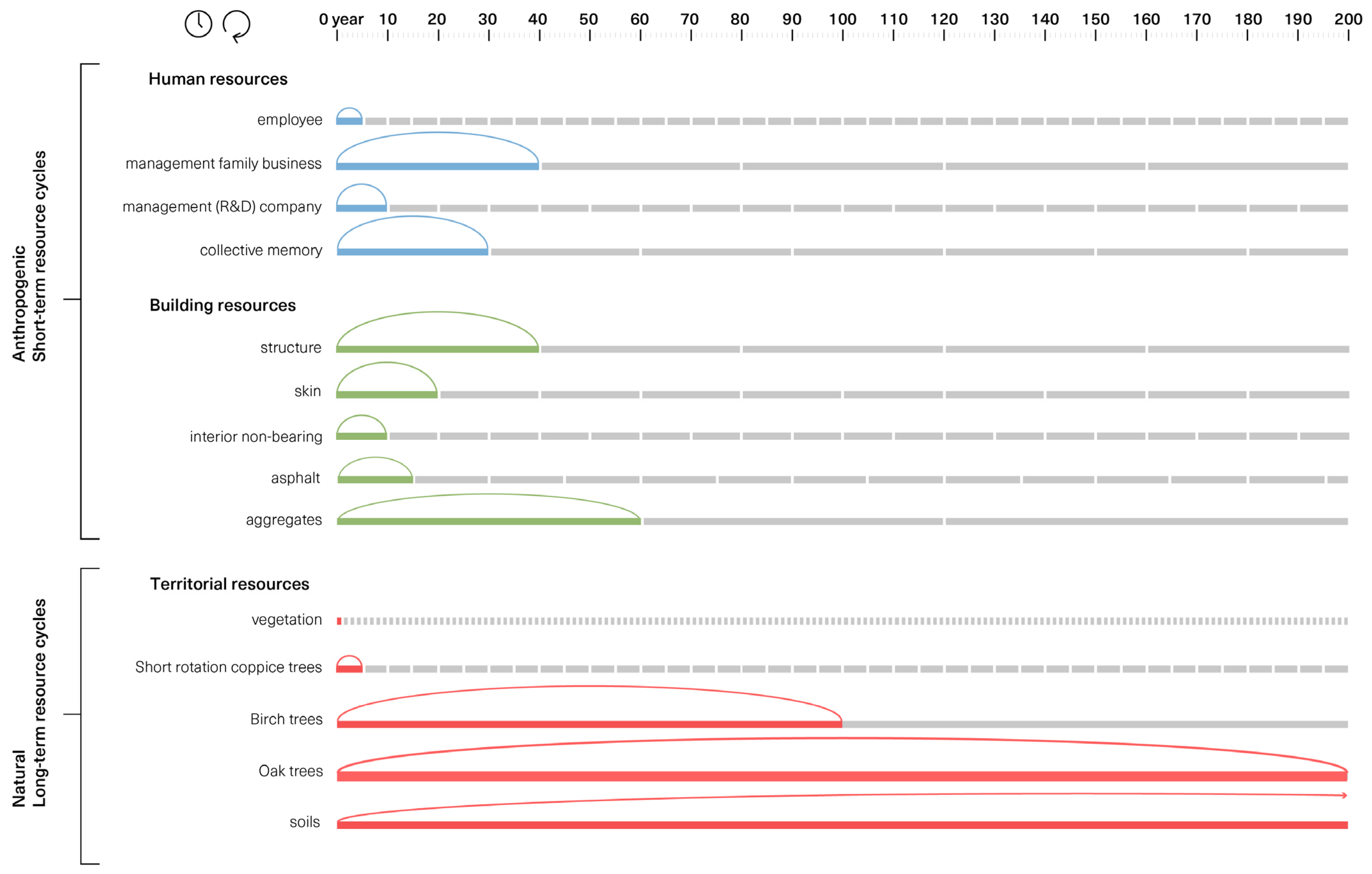


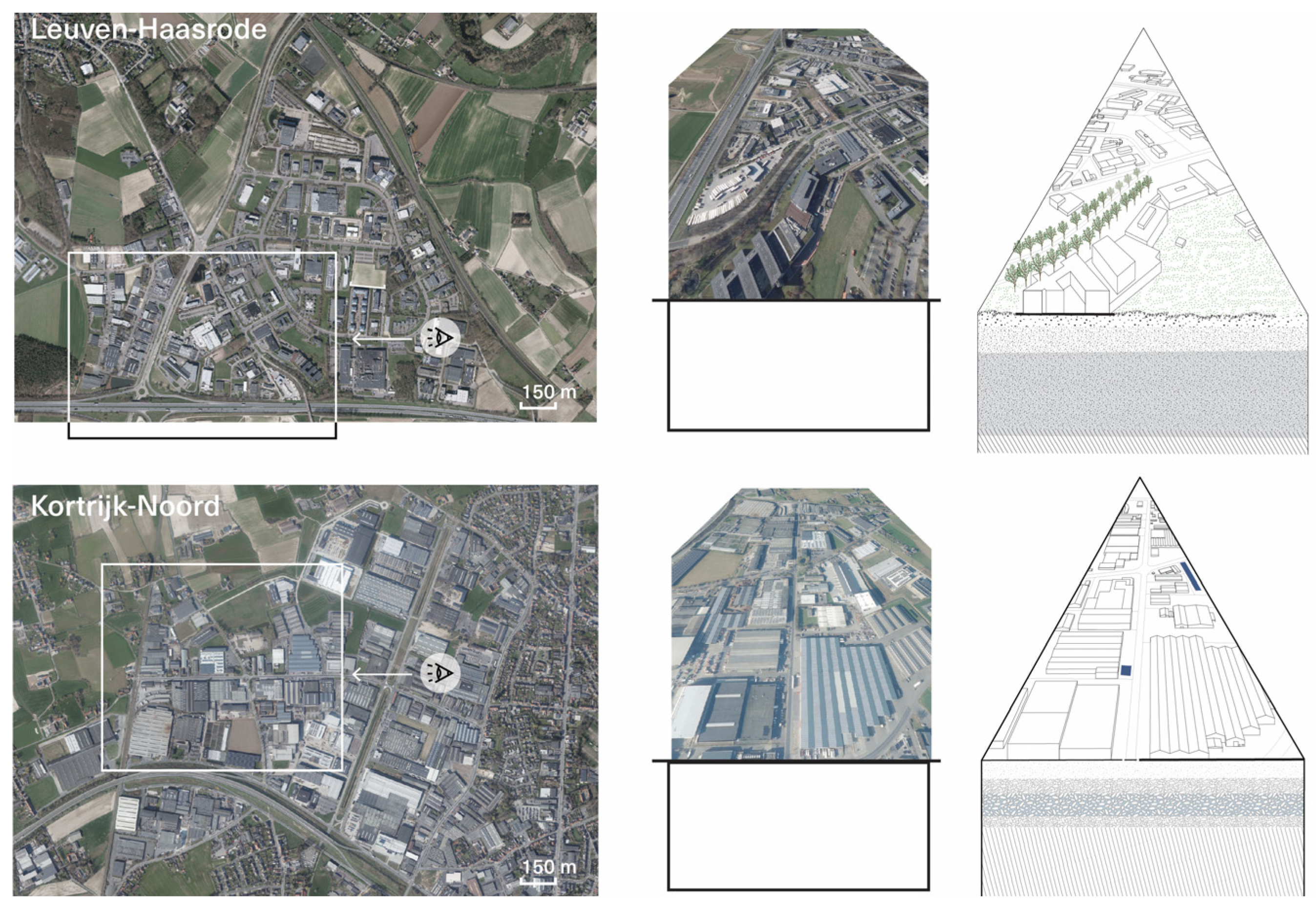
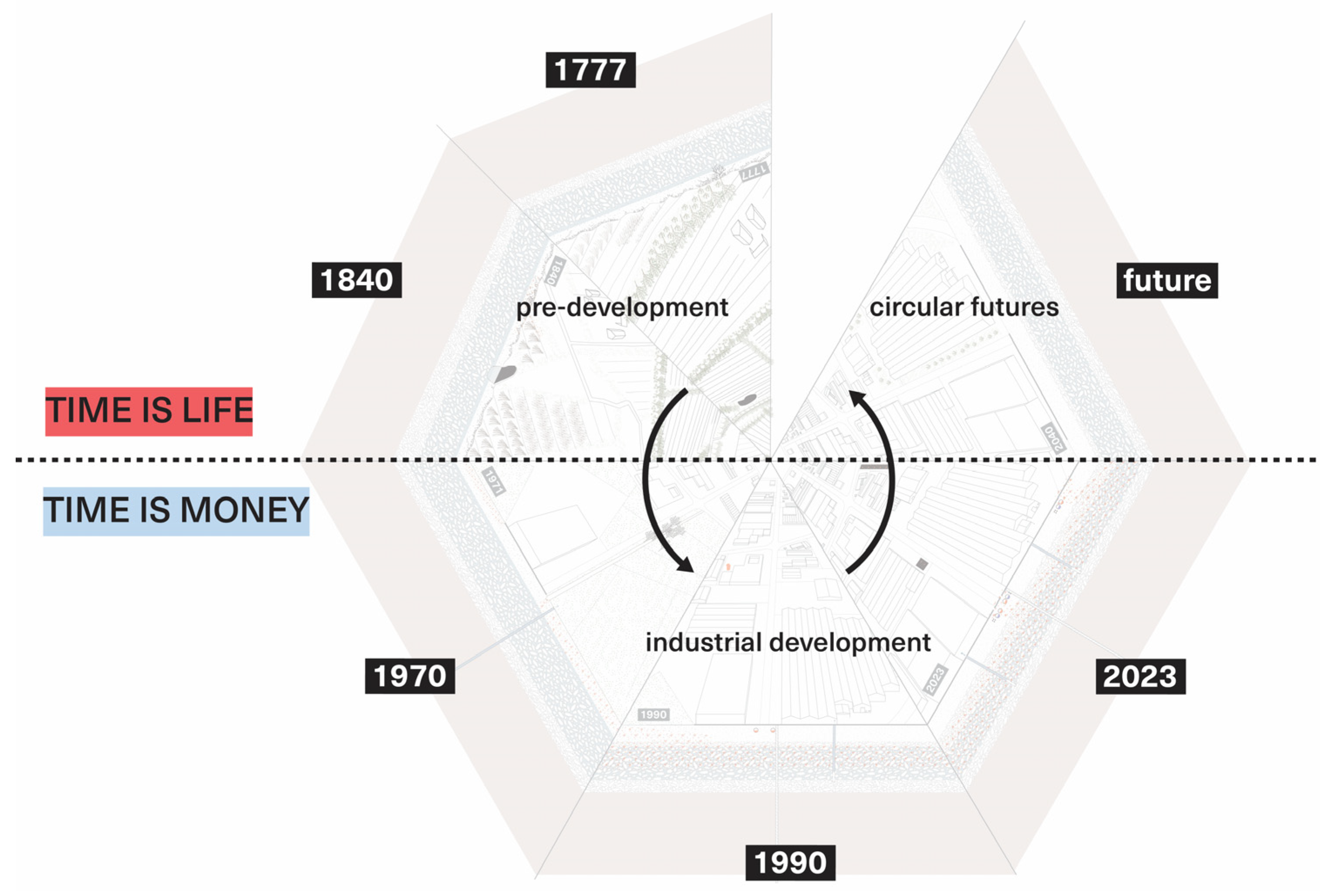


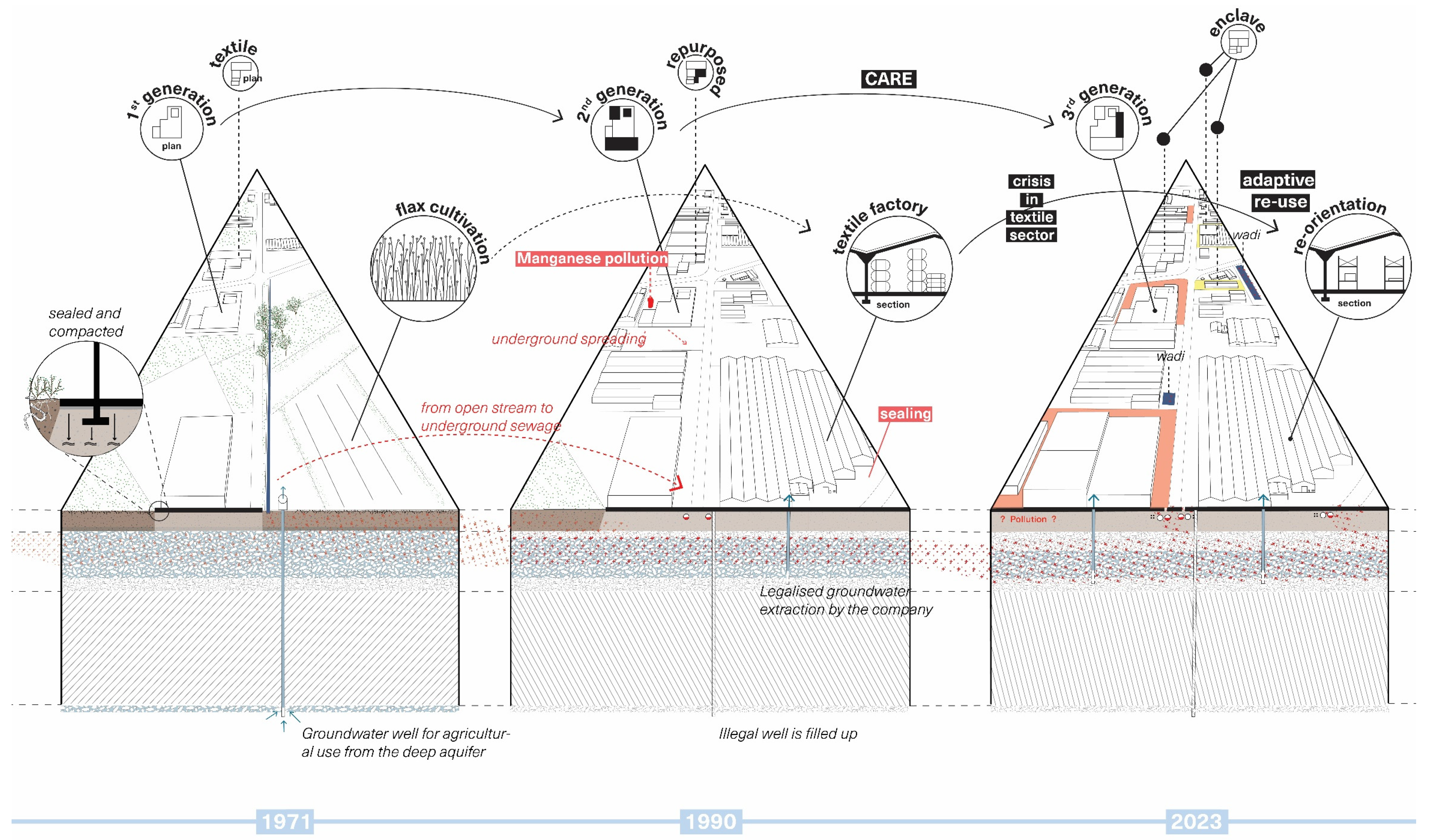
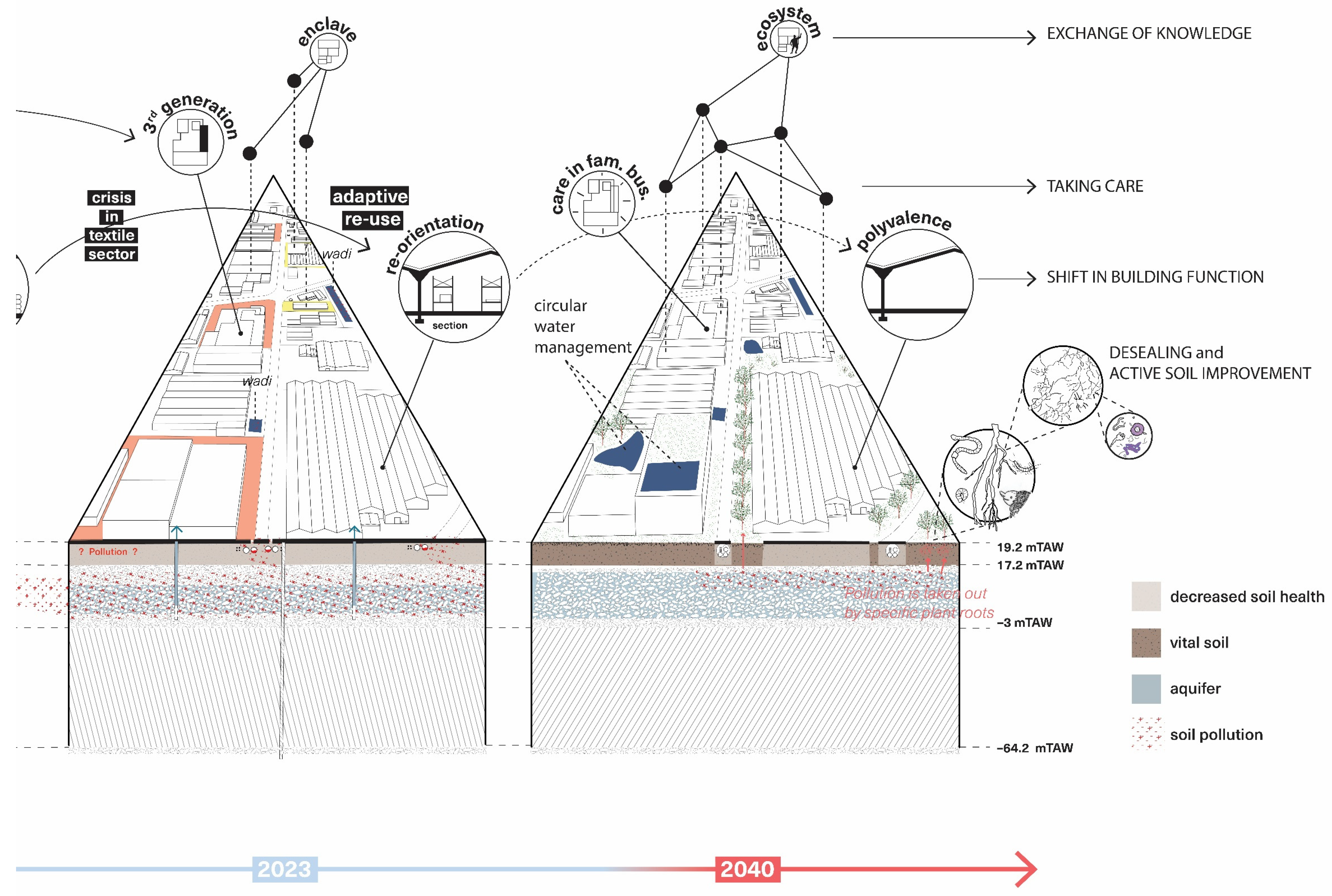
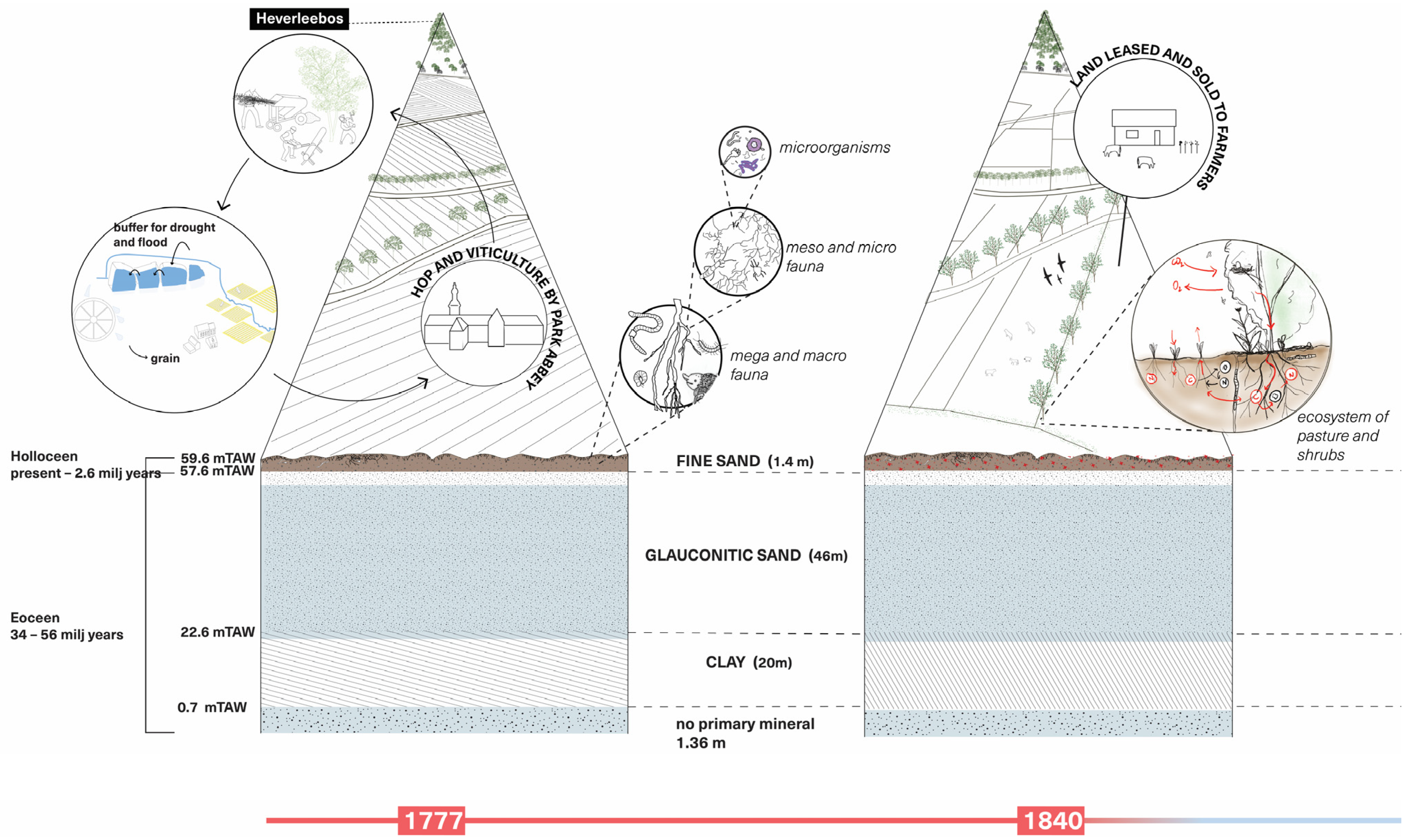
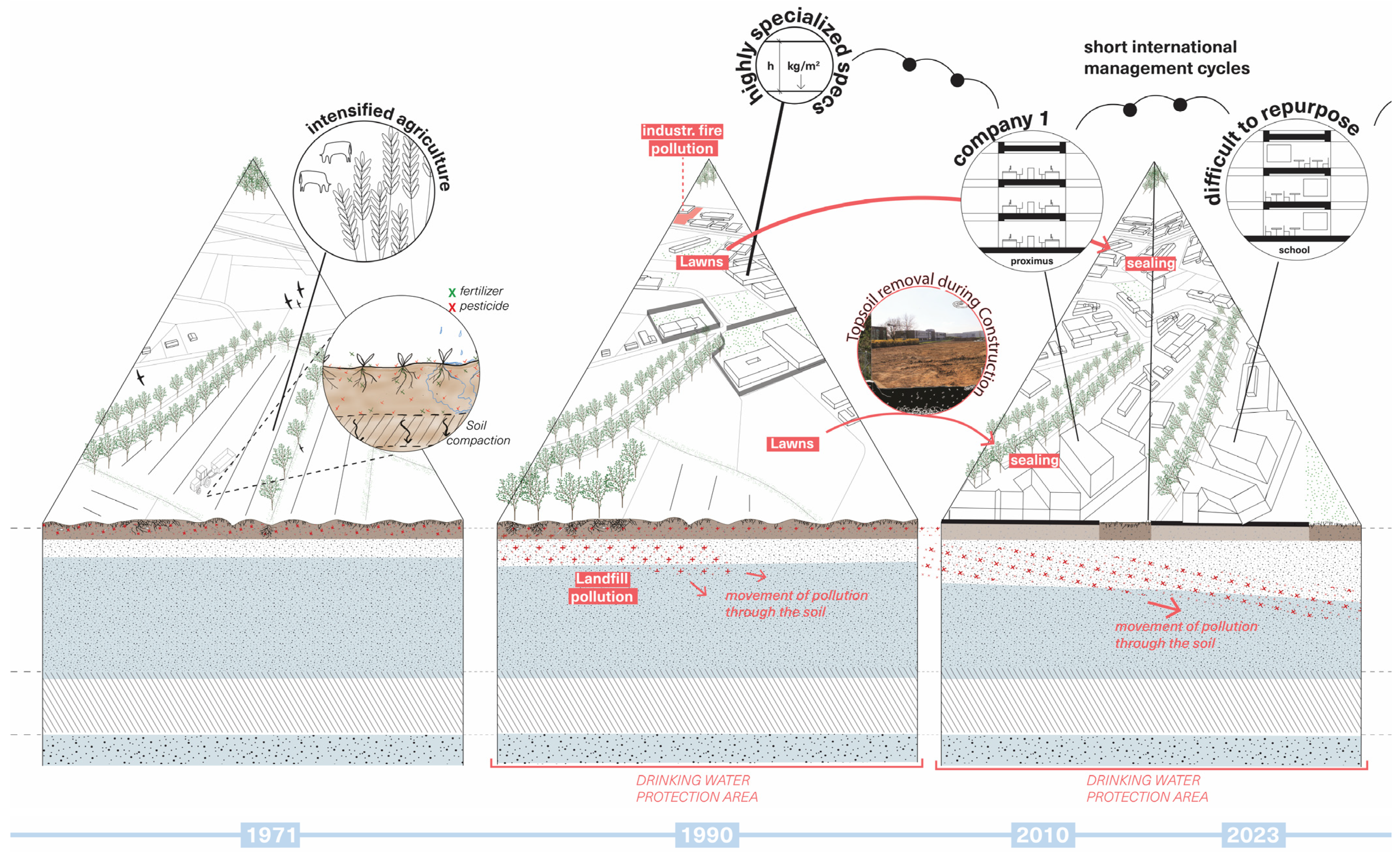


Disclaimer/Publisher’s Note: The statements, opinions and data contained in all publications are solely those of the individual author(s) and contributor(s) and not of MDPI and/or the editor(s). MDPI and/or the editor(s) disclaim responsibility for any injury to people or property resulting from any ideas, methods, instructions or products referred to in the content. |
© 2024 by the authors. Licensee MDPI, Basel, Switzerland. This article is an open access article distributed under the terms and conditions of the Creative Commons Attribution (CC BY) license (https://creativecommons.org/licenses/by/4.0/).
Share and Cite
Timmers, C.; Verbiest, E.; Ottoy, S.; Marin, J. Integrating Temporal Dimensions in Circularity of the Built Environment Analysis of Two Flemish Industrial Parks. Sustainability 2024, 16, 11053. https://doi.org/10.3390/su162411053
Timmers C, Verbiest E, Ottoy S, Marin J. Integrating Temporal Dimensions in Circularity of the Built Environment Analysis of Two Flemish Industrial Parks. Sustainability. 2024; 16(24):11053. https://doi.org/10.3390/su162411053
Chicago/Turabian StyleTimmers, Charlotte, Ellen Verbiest, Sam Ottoy, and Julie Marin. 2024. "Integrating Temporal Dimensions in Circularity of the Built Environment Analysis of Two Flemish Industrial Parks" Sustainability 16, no. 24: 11053. https://doi.org/10.3390/su162411053
APA StyleTimmers, C., Verbiest, E., Ottoy, S., & Marin, J. (2024). Integrating Temporal Dimensions in Circularity of the Built Environment Analysis of Two Flemish Industrial Parks. Sustainability, 16(24), 11053. https://doi.org/10.3390/su162411053







